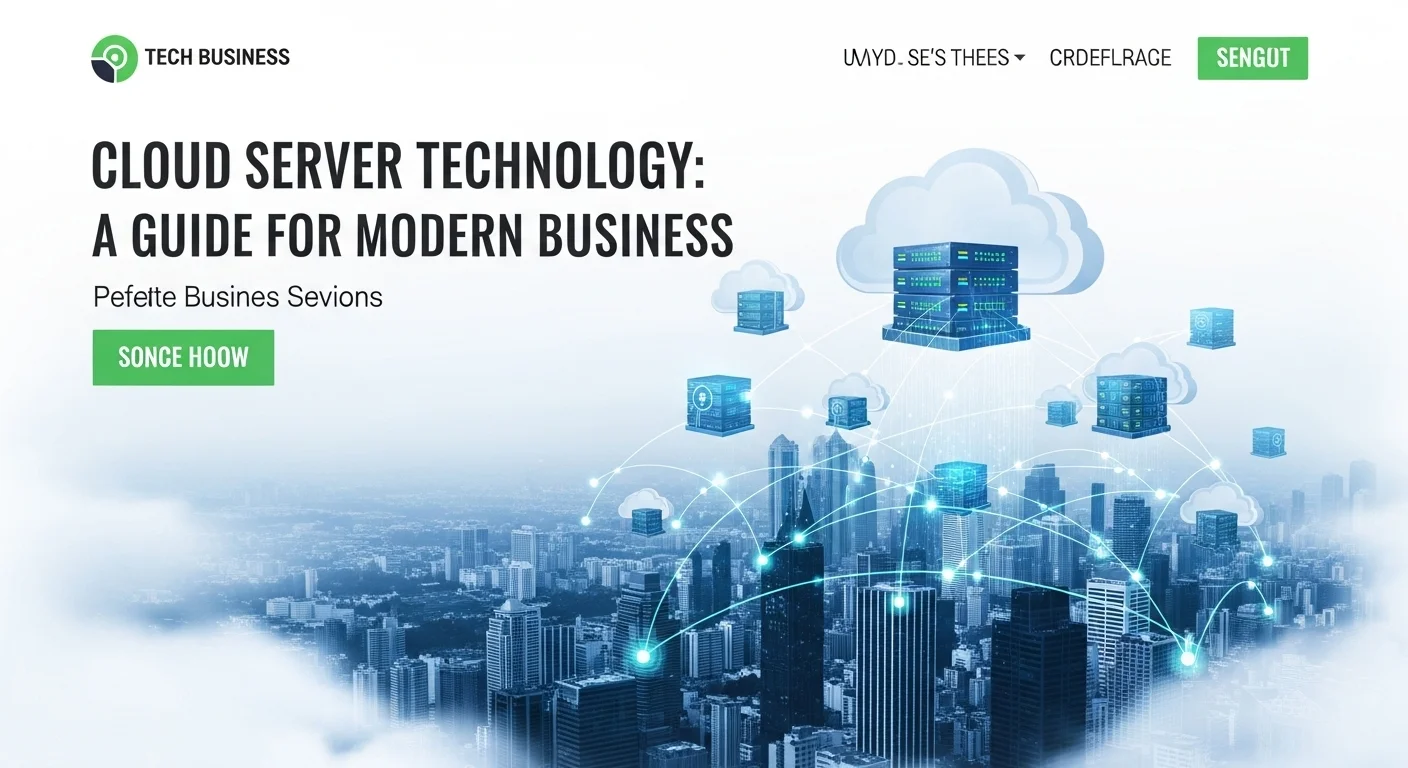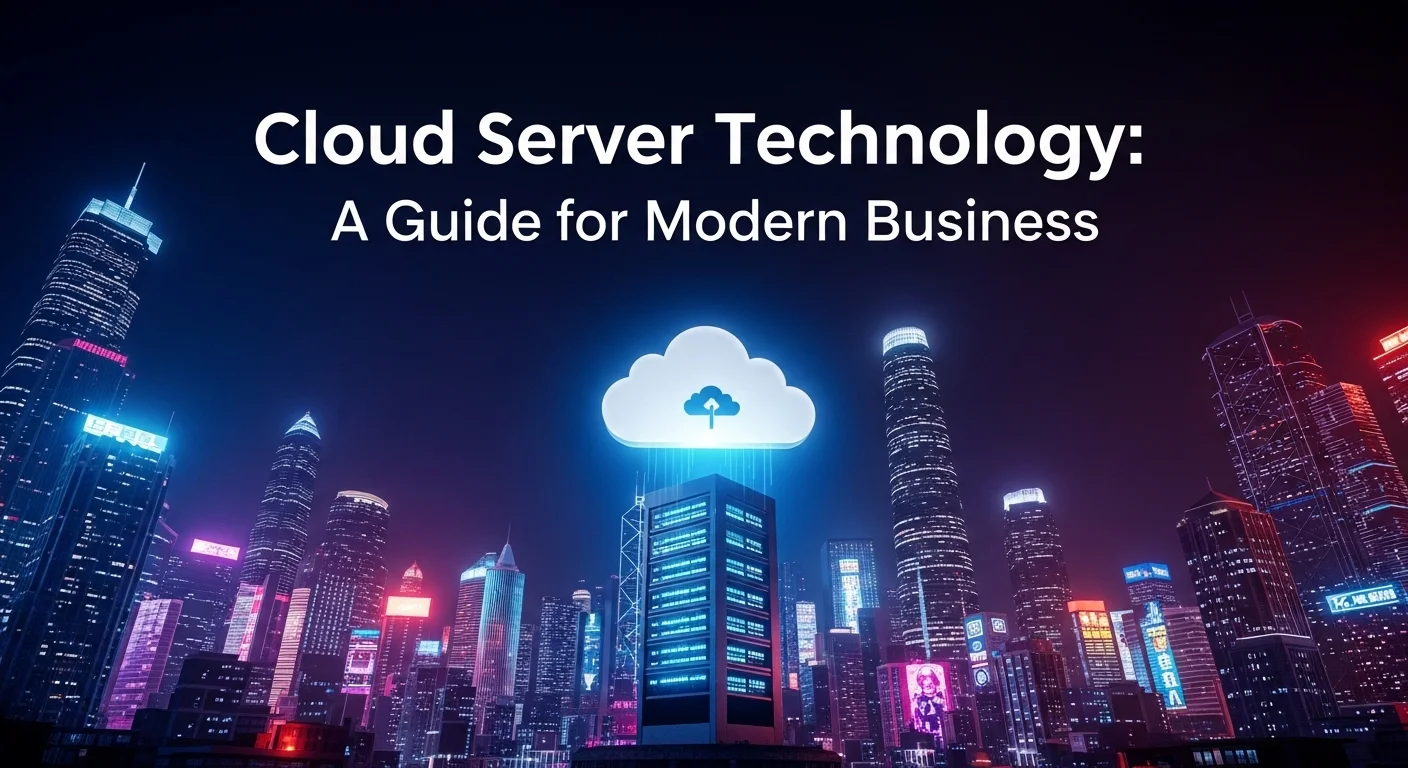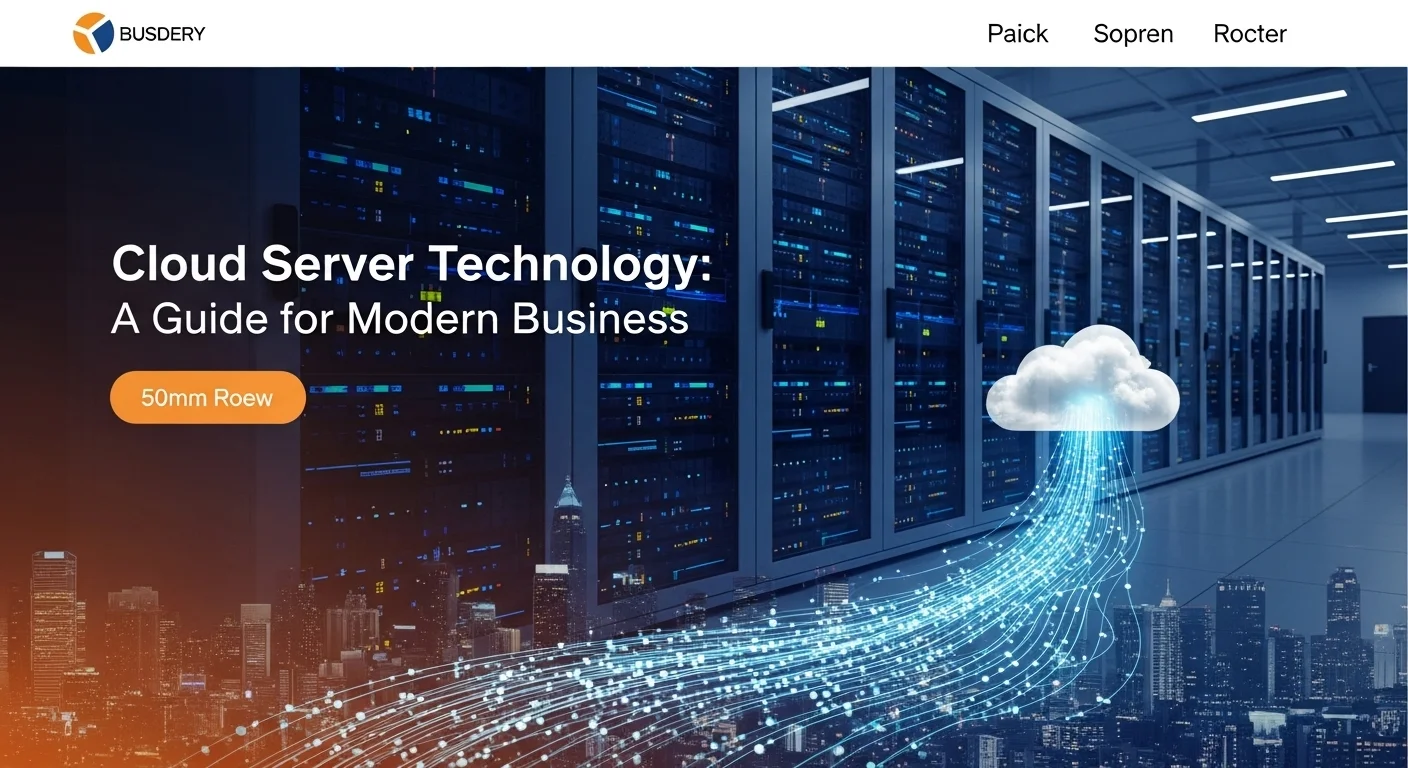What Is a Cloud Server? A Plain-English Guide for Your Business

Executive Summary
In my years working with businesses, I've seen the monumental shift from noisy, expensive server rooms to the sleek, powerful world of cloud computing. At the heart of it all is the cloud server. But what does that really mean? Put simply, it’s a powerful computer that you access over the internet, instead of one you own and maintain yourself. This article is my attempt to cut through the jargon and give you a straightforward guide. We'll explore what these virtual servers are, why they're a game-changer for businesses of any size, and the real-world benefits like saving money and scaling on demand. I'll walk you through choosing the right setup—from public options like AWS and Azure to private and hybrid models—and we'll tackle the big topics: keeping your data secure, managing storage smartly, and creating a backup plan that lets you sleep at night. My goal is to make your tech infrastructure a genuine competitive advantage, not just another line item.
Table of Contents
Table of Contents
- What is a Cloud Server and Why Does It Matter?
- How Does It Actually Work? The Magic of Virtualization
- The Real-World Benefits for Your Business
- Understanding Cloud Storage and Security
What is a Cloud Server and why is it important in Technology?
In today's tech world, 'the cloud' is everywhere, from how we store family photos to how giant corporations run their entire operations. I remember the days of maintaining physical servers—the noise, the heat, the constant worry about hardware failure. The Cloud Server changed all of that. Think of it not as a physical box in your office, but as a 'slice' of a massive, powerful computer owned by a provider like Amazon or Google. You rent this slice and access it over the internet. This simple idea marked a huge shift. We went from spending a fortune on hardware upfront to a flexible, pay-as-you-go model that's far more efficient.
The technology that makes this possible is called virtualization. It's a bit like taking a powerful physical server and using special software (a hypervisor) to split it into multiple, isolated virtual machines (VMs). Each VM acts like its own independent server, with its own operating system and software. It's the ultimate in resource sharing. This process allows one physical machine to host many virtual ones, which is what gives the cloud its incredible flexibility and scalability. All these physical machines, virtualization software, and management tools together form the cloud computing infrastructure that powers so much of our digital world.
The Core Importance of Cloud Server Technology
The impact of this technology on business is impossible to ignore. It’s the backbone for countless digital services we now take for granted. The main draws are scalability, cost savings, reliability, and easy access. Scalability is the star of the show. I’ve worked with e-commerce sites that would have crashed during a holiday sale with old-school servers. With the cloud, if you get a sudden traffic spike, you can add more computing power with a few clicks and then scale back down when things quiet down. You only pay for what you use. This pay-as-you-go approach saves a ton of money by cutting out the massive initial hardware costs and the ongoing expenses of maintenance and electricity for an on-premise server room.
Reliability is another huge win. Cloud providers build their data centers with layers upon layers of redundancy. If one piece of hardware fails, your virtual server is automatically and seamlessly moved to another healthy one, usually without you or your customers ever noticing. This level of resilience is incredibly expensive and complex for a single business to build on its own. This infrastructure is also key to a smart backup strategy. Your data can be copied to different locations around the world, protecting you from everything from a local power outage to a regional disaster. I can't stress this enough: a reliable cloud backup plan is your ultimate defense against data loss, whether it's from a hardware glitch, a cyberattack, or simple human error.
Exploring Cloud Server Services and Storage
The cloud isn't a one-size-fits-all solution. It's offered in different models to fit various needs, mainly Infrastructure as a Service (IaaS), Platform as a Service (PaaS), and Software as a Service (SaaS). A cloud server is the core of IaaS. Here, the provider gives you the raw computing power, network, and storage, and you manage the rest (like the operating system and applications). This offers the most control. PaaS adds another layer, managing the operating system for you so developers can just focus on building apps. SaaS is what most people use daily—think Gmail or Salesforce, where the entire application is delivered online. All of these models are built on top of a cloud computing server foundation.
Storage is a critical piece of the puzzle. With a cloud server, storage is usually a separate, incredibly scalable service. You aren't limited by the physical disks in one machine. Services like Amazon S3 or Google Cloud Storage offer practically endless and durable storage space that you can easily connect to your servers. Separating computing from storage is a brilliant move. It means you can boost your processing power for a big event without having to pay for more permanent storage, or vice versa. This setup is also perfect for backups, as you can save snapshots of your server's state cheaply and safely in these storage services.
The Imperative of Cloud Server Security
When you move your business-critical data and applications online, security naturally becomes a top priority. The good news is that major cloud providers invest billions in physical security for their data centers—far more than any single company could afford. But security is a partnership, what we in the industry call a 'shared responsibility model.' The provider secures the cloud itself (the physical buildings, the hardware), but you are responsible for securing what you put *in* the cloud. This means setting up your virtual server correctly, managing who has access, and protecting your applications and data.
A strong security posture requires multiple layers. It starts with strict identity and access rules to ensure only the right people can manage your servers. Network security is next, using virtual firewalls to control who and what can communicate with your setup. Your data should always be encrypted, both when it's traveling over the network and when it's being stored. Finally, constant monitoring is crucial for spotting any suspicious activity early. When you combine a secure setup with smart storage management and a robust backup plan, you create a truly resilient and safe foundation for your business in the digital age.

Complete guide to Cloud Server in Technology and Business Solutions
Getting your head around cloud server technology is crucial for any business that wants to stay competitive. Understanding your options and how to implement them strategically can be the difference between a simple IT update and a real business transformation. This guide is my deep dive into the world of cloud computing servers, designed to help you make smart decisions with confidence.
Choosing Your Cloud Deployment Model: Public, Private, and Hybrid
Your first big decision is how you want to deploy your cloud environment. Think of it like real estate. You can rent, own, or do a bit of both. Each model has its own pros and cons.
Public Cloud Servers: This is like renting an apartment in a massive, well-maintained building. A provider like Amazon Web Services (AWS), Microsoft Azure, or Google Cloud owns and manages all the hardware, and you rent virtual server instances from them. The benefits are huge: incredible scalability, no upfront hardware costs, and a massive menu of services. I’ve seen startups go from an idea to a global service in weeks using the public cloud. It's perfect for new projects, websites with fluctuating traffic, and development work.
Private Cloud Servers: This is like owning your own house. The computing resources are dedicated exclusively to your business. It can be physically located in your own data center or hosted by a third party for you. The main reason to do this is for maximum control and privacy, which is often a must for industries like finance or healthcare with strict compliance rules. It offers great customization but usually comes with a higher price tag and more management responsibility.
Hybrid Cloud Servers: This model is the best of both worlds. It’s like owning your house but also renting a flexible storage unit for seasonal items. You can keep your most sensitive data and applications in your private cloud for security, while using the public cloud's power for less critical tasks, disaster recovery, or to handle unexpected traffic spikes (a practice we call 'cloud bursting'). It's the ultimate in flexibility but requires careful planning to make sure the two environments can talk to each other securely.
Major Cloud Providers and Their Server Offerings
A few giants dominate the cloud market, and each has its flagship server product.
- Amazon Web Services (AWS): The original leader, AWS offers Amazon EC2. I've used EC2 for years, and its variety is astounding. You can find a virtual server optimized for almost any job imaginable. The AWS ecosystem is mature, well-documented, and trusted by millions.
- Microsoft Azure: Azure's core product is Azure Virtual Machines. Its biggest strength is its seamless integration with other Microsoft products. If your business runs on Windows Server and Office 365, Azure often feels like a natural extension. Their hybrid cloud solutions are particularly strong.
- Google Cloud Platform (GCP): GCP's solution is the Google Compute Engine. I've always been impressed by GCP's strengths in high-speed networking, data analytics, and AI. They are also the creators of Kubernetes, the leading technology for managing containerized applications, giving them a home-field advantage in that space.
When you compare them, don't just look at the hourly price of a server. I always tell my clients to consider the whole package: the range of services, network performance, global reach, support quality, and the tools they provide for managing security and storage.
Technical Deep Dive: Configuring Your Cloud Server
Once you've picked a provider and model, it's time to set up your server. This involves a few key choices:
- Instance Type: This is about picking the right mix of processing power (CPU), memory (RAM), and network speed for your specific application.
- Operating System: You'll have your choice of popular Linux versions (like Ubuntu or CentOS) or Windows Server.
- Cloud Storage: This is a big one. You'll use 'block storage' (like a virtual hard drive) for your server's OS and active files. Then there's 'object storage,' which is perfect for storing huge amounts of data like images, videos, and, most importantly, your backups. It's incredibly durable and cheap, making it the ideal choice for your disaster recovery plan.
- Networking: You'll create a Virtual Private Cloud (VPC), which is your own logically isolated section of the public cloud. Here you can define your own IP addresses and network rules to control traffic and lock things down.
Business Techniques for Cloud Server Implementation
Adopting the cloud is more than a tech project; it's a business strategy. A common first step is 'lift-and-shift,' where you move an existing application as-is from your old hardware to a cloud server. It's a quick win. But the real magic happens when you start building 'cloud-native' applications—apps designed from the ground up to use features like auto-scaling and serverless functions. This is where you see massive gains in efficiency and innovation.
Another key technique is what we call 'FinOps,' or financial operations. With a pay-as-you-go model, it’s easy for costs to spiral if you’re not careful. It’s essential to monitor your spending, tag resources to see which department is using what, and shut down wasted resources like idle servers. Committing to one- or three-year plans for your steady workloads can also unlock huge discounts.
Ensuring Resilience with Backups
No discussion about cloud servers is complete without hammering home the importance of backups for business continuity. Even the most reliable cloud infrastructure won't protect you from a user accidentally deleting a critical file or a ransomware attack. A solid backup strategy is non-negotiable. Modern cloud services make this easy. You can schedule automated 'snapshots' of your servers that save their state. These backups should be stored securely in object storage, and for true peace of mind, copied to a completely different geographic region. This ensures that even if an entire data center goes down, you can restore your business operations elsewhere and keep moving forward.

Tips and strategies for Cloud Server to improve your Technology experience
Getting onto the cloud is the start of the journey, not the end. To really get your money's worth and turn your technology into a competitive advantage, you need to go beyond the basics. Here are some of the most important lessons I've learned for optimizing your cloud environment, focusing on performance, cost, security, and using the full power of the cloud ecosystem.
Best Practices for Cloud Server Security
In my experience, security can't be an afterthought. It has to be baked into your strategy from day one. Here’s my no-nonsense approach to cloud security.
- Adopt a 'Zero Trust' Mindset: My motto is 'never trust, always verify.' This means every user and device, whether they're inside or outside your network, must prove their identity every single time. Enforce Multi-Factor Authentication (MFA) everywhere you possibly can. Give users the absolute minimum permissions they need to do their jobs and nothing more.
- Automate Your Defenses: The cloud is dynamic. Servers spin up and down constantly. Trying to manually configure each one is a recipe for disaster. Use automation tools to enforce security settings and apply patches automatically. This closes security holes fast and keeps your defenses consistent.
- Build a Virtual Fortress: Use the cloud's virtual firewalls (known as security groups or network access control lists) to lock down your servers. The best practice is to deny all traffic by default and then poke very specific holes for only the traffic your application needs. For any web-facing application, a Web Application Firewall (WAF) is a must-have to block common attacks.
- Be a Watchful Guardian: You can't protect what you can't see. Turn on comprehensive logging and use monitoring tools that use AI to detect weird behavior or potential threats. I always recommend regular security audits and hiring ethical hackers to test your defenses. It’s better to find the weaknesses yourself before a real attacker does.
Optimizing Cloud Server Storage and Backup
Getting storage and backups right is the secret to controlling costs and ensuring you can recover from anything. Badly managed storage is one of the most common ways I see companies waste money.
- Use Smart Storage Tiers: Not all your data needs the same treatment. Use the fast, expensive SSD storage for your active databases and applications. For data you don't access often, move it to cheaper, slower storage tiers. Set up automated rules to move old data to even cheaper 'archive' storage over time. It’s a simple change that can save a fortune.
- Automate and Test Your Backup Plan: A good backup strategy is your ultimate safety net. Set up automated daily snapshots of your servers. But here's the part people forget: you have to test them! Regularly try to restore from a backup in a test environment to make sure it actually works. For your most critical systems, copy those backups to another part of the world to protect against a regional disaster.
- Clean Up After Yourself: It's incredibly common to have 'orphaned' resources—storage drives or backups that are no longer connected to any active server but are still quietly costing you money every month. Run regular automated checks to find and delete this junk.
Cost and Performance Optimization Strategies
The cloud's flexibility is a double-edged sword. It’s powerful, but you have to manage it wisely to get the best performance for the best price.
- Embrace Auto-Scaling: This is one of the coolest features of the cloud. You can set up rules to automatically add more servers when your site gets busy and then remove them when traffic dies down. This ensures you always have enough power for peak times without paying for servers that are just sitting idle most of the day.
- Get the Right Size (Right-Sizing): It’s tempting to buy a bigger server than you need 'just in case.' Don't do it. Use the cloud's built-in monitoring tools to see how much power and memory your servers are actually using. If a server is consistently bored, shrink it to a smaller, cheaper size. If it's constantly struggling, give it an upgrade.
- Commit and Save: If you have workloads that run 24/7, like a production database, tell your cloud provider you'll use it for one or three years. In exchange for this commitment, they'll give you massive discounts—sometimes up to 70% off the on-demand price. This is the single most effective way to slash your cloud bill.
- Think Beyond the Server: For new projects, look at modern architectures that are even more efficient. 'Serverless' computing lets you run code without thinking about servers at all—you pay only for the split-seconds your code is running. 'Containers' are another great technology that lets you pack your applications more efficiently onto the underlying hardware.
By truly mastering these strategies, you can transform your cloud environment from a simple utility into a powerful strategic asset. A well-run cloud, built on strong security, smart storage, a reliable backup plan, and optimized services, gives you the agility and power to out-innovate the competition. For those who want to go even deeper, I highly recommend reading the AWS Well-Architected Framework. It's a goldmine of expert guidance.
Expert Reviews & Testimonials
Sarah Johnson, Business Owner ⭐⭐⭐
The information about Cloud Server is correct but I think they could add more practical examples for business owners like us.
Mike Chen, IT Consultant ⭐⭐⭐⭐
Useful article about Cloud Server. It helped me better understand the topic, although some concepts could be explained more simply.
Emma Davis, Tech Expert ⭐⭐⭐⭐⭐
Excellent article! Very comprehensive on Cloud Server. It helped me a lot for my specialization and I understood everything perfectly.



